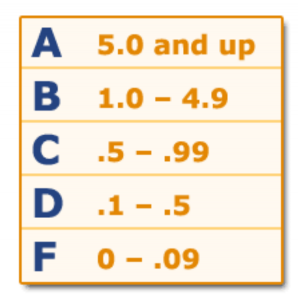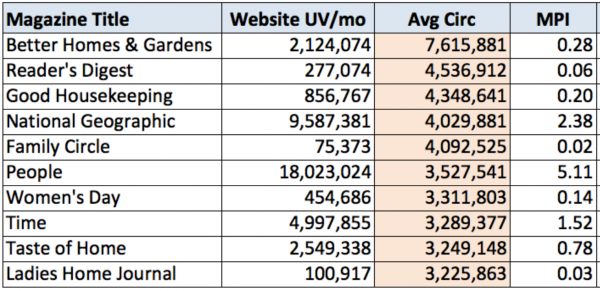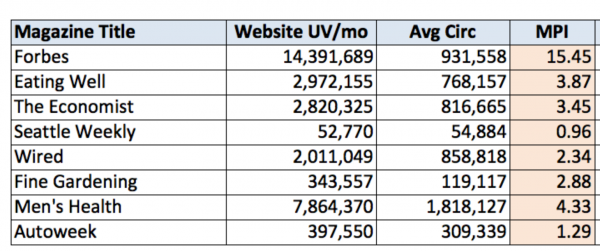If your website doesn’t attract at least 5x more free visitors than paid subscribers – your publication is probably in trouble
Marketing expert Seth Godin recently spoke at the HOW magazine conference and said, “I can reach 10 times more people writing a blog post than writing a book.” I’ve always liked that guy.
If you apply that logic to magazine publishing, then you should at least be able to get as many free online Portal visitors as subscribers to your paid magazine, if not ten times more.
A portal is not a blog – although it typically includes a blog on its homepage. Portals are intended to build and feed an audience; they are specifically designed for SEO, email marketing, list building, and lead generation. Portal subscription websites generate value from both the users and the sponsors. Users pay—not with money (all website content is free) but with time and information. See Investing Daily, Psychotherapy Networker, Bayou City and Nutrition Action for just a few Mequoda-built examples.
The Mequoda Portal Index (MPI) is a mathematical equation that can immediately tell the effectiveness of any publisher’s online strategy – and we don’t even need to take a peek at your SEO, content, or audience development efforts first. The story is in the numbers.
What’s your MPI?
To find out how your Portal fares, simply take your Monthly Average Users (MAU) of Website and divide it by your Average Issue Circulation (AIC). The number should at least be 1.0, meaning the amount of traffic your Portal gets each month is equal to your magazine’s paid circulation.

As mentioned previously, we think any magazine should be able to get a score of at least one, but ideally they should have a five or above.
Finding these numbers is simple not only for yourself, but also for your competitors. Compete and Quantcast provide websites’ unique visitor counts, and the new Alliance for Audited Media will provide a publication’s verified circulation numbers.
In theory, it should be easy to get more free traffic to your Portal than subscribers to your magazine per month because web traffic is free. It’s completely dependent on how much you give away and how well optimized your content is for search engines. Understanding the Mequoda Method is crucial to improving all of the above.
How did your publication do? If you are in the A to B range, congratulations, you are doing an excellent job driving your audience to your Portal. If your score is any lower than a 1.0, you should consider the record-setting growth that the online advertising industry is achieving and how you are going to capture that growth.
[text_ad]
How The “Top” Magazines Compare
But still, most of the top circulated magazines haven’t even made a dent in web traffic compared to paid circulation. Below are the top ten magazines in the U.S. based on unique visitors from the last two quarters of 2013 and the average circulation for 2013.

As you can see from the chart above, People is the only publisher with an MPI of 5 or more, while Time and National Geographic get a B. The rest of the “top” magazines pale in comparison.
The reason why this is so important is that a publication like Family Circle, which is already in the top ten list for circulation, is leaving money on the table by not boosting traffic to their Portal, FamilyCircle.com. Imagine if they brought their score of .02 to a 5 like People? They could be at the top of the list! And they could be monetizing that website traffic in a variety of ways, including the Mequoda Best Practice of converting them to subscribers to a free email newsletter which you can then monetize through sponsorships, selling your own premium products, or both. Instead, their site gets less traffic than a mommy blogger and so it can’t be used to sell more magazine subscriptions.
How Nimble Niche Magazines Compare
A niche magazine is unlikely to ever end up on the top ten list for the very basic reason that they have a much smaller audience. They do, however, tend to blow their general audience counterparts out of the water. Just look at Forbes, whose Portal gets more than 15x the amount of traffic to their site than their magazine circulation.
To get to this point, they have learned how to use content, SEO, email newsletters and social media to build an online audience that’s larger, often vastly larger, than the circulation of the magazine whose brand they share. They understand that while their basic website may use a magazine brand, it’s a totally different medium and requires a unique system of publishing strategies to power online success.

This represents an opportunity, whether they choose to take advantage or not, to build 3C conversion architecture and turn their sites into subscription-generating machines. If you’d like to know how you can increase your score, I suggest you read:
- Understanding the Mequoda Method for Multiplatform Publishing
- What is a Mequoda Portal?
- Mequoda 3C Conversion Architecture
- The Lifecycle of Recycling Magazine Articles
- The New Mequoda Pyramid
If you scored less than 1 on the MPI chart and run (or plan to launch) a niche magazine Portal, please schedule a call with me. I’d love to talk with you about how to build your own Mequoda System using the Mequoda Method.
The Mequoda Method consists of a proven, fully integrated, low-cost, high-efficiency system that helps publishers launch incredibly successful online publishing and marketing operations. It’s a system we’ve designed and perfected over the past 15 years – on our way to helping more than 110 brands achieve multiplatform publishing success.



For this reason the CVS drug store need to deal with all the staff members as well as personnel. However it is not that simple to care for them like it is while claiming.
that implies company like an offset cigarette smoker. For several years, these hunka-hunka cigarette smokers.